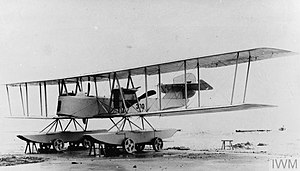Friedrichshafen FF.35
| FF.35 | |
|---|---|

| |
| The FF.35 with axles installed underneath its floats | |
| Role | Floatplane torpedo bomber |
| Manufacturer | Flugzeugbau Friedrichshafen |
| First flight | 1916 |
| Primary user | Imperial German Navy |
| Number built | 1 |
| Developed into | Friedrichshafen FF.41 |
The Friedrichshafen FF.35 was a German three-seat
Development
After the
Friedrichshafen's submission was similar in general design to their
The torpedoes used by the FF.35 and other German torpedo bombers were not designed for aerial use and had very narrow parameters for a successful launch, namely that the aircraft had to be flying straight and level and at an altitude of no more than 10 meters (33 ft). To give pilots a method by which all of these conditions could be judged, the aircraft were fitted with an
Operational history
The SVK placed an order for one prototype in February 1915,[Note 1] but construction was significantly delayed by Friedrichshafen's existing commitments and did not begin until 2 February 1916. It was delivered to the SVK in May for testing which was completed on 24 May and the aircraft received the serial number (Marine-nummer) 300.[Note 2] The performance of the FF.35 was deemed satisfactory, but it was structurally obsolete by the time it was delivered. Although no further examples were built, the FF.35 formed the basis for the more successful and streamlined FF.41.[6]
The Naval Air Service began flying bombing missions with the FF.35 from the
Specifications
Data from Flugzeugbau Friedrichshafen GmbH: Diplom-Ingenieur Theodor Kober;[8] Friedrichshafen Aircraft of WWI: A Centennial Perspective on Great War Airplanes[5]
General characteristics
- Crew: 3
- Length: 13.5 m (44 ft 3 in)
- Upper wingspan: 23.74 m (77 ft 11 in)
- Lower wingspan: 21.02 m (69 ft 0 in)
- Height: 4.5 m (14 ft 9 in)
- Wing area: 100 m2 (1,100 sq ft)
- Empty weight: 2,292 kg (5,053 lb)
- Gross weight: 3,543 kg (7,811 lb)
- Powerplant: 2 × Mercedes D.III water-cooled straight-six engines, 120 kW (160 hp) Originally measured as 160 PS each
- Propellers: 2-bladed pusher propellers
Performance
- Maximum speed: 114 km/h (71 mph, 62 kn)
- Range: 770 km (480 mi, 420 nmi)
Armament
- Guns: 1 or 2 × 7.92 mm (0.312 in) Parabellum MG14machine-guns
- Bombs: 1 × 726 kg (1,601 lb) torpedo
See also
Related development
Aircraft of comparable role, configuration, and era
Related lists
Notes
Footnotes
Bibliography
- Borzutzki, Siegfried (1993). Flugzeugbau Friedrichshafen GmbH: Diplom-Ingenieur Theodor Kober [Friedrichshafen Aircraft Company: Diploma-Engineer Theodore Kober] (in German). Berlin: Burbach. ISBN 3-927513-60-1.
- Herris, Jack (2016). Friedrichshafen Aircraft of WWI: A Centennial Perspective on Great War Airplanes. Great War Aviation Centennial Series. Vol. 21. n.p.: Aeronaut Books. ISBN 978-1-935881-35-3.
- Schmeelke, Michael (2020). "Torpedo Los!": The German Imperial Torpedo-Flieger. n.p.: Aeronaut Books. ISBN 978-1-953201-17-1.
